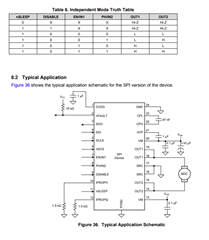Hi Team,
Our customer is using a DRV8873 in hardware independent mode to run a 24DCV ~0.7A running motor. However, they encountered some issue with this device during testing. According to the customer,
After some life testing the driver seems to be unexpectedly and intermittingly driving Out2 high for exactly 0.5 seconds, then the driver continues functioning as expected. During this time I am monitoring several voltages and nothing seems out of sync, except for IN2 (low) and Out2 (high).
• nFault is high and never is driven low
o This should mean that the internal protections are not triggering; Undervoltage, Overcurrent, Thermal, Open load.
• IN2 is confirmed to be low during the intermittent time where Out2 unexpectedly goes high.
o At this time IN1 is high and Out1 is high
• VCP is always measuring ~ VM+5
• VM is always measuring 23VDC
• DVDD is always measuring ~ 5VDC
• Current draw is .7A (measured through IPROPI)
• Slightly elevated ambient temperature 200F/93C
The fact this unexpected function occurs for exactly 0.5 seconds then resumes has me quite perplexed. Based on my measurements, I am not sure what else other than the internal pre-driver or MOSFETs could be at fault and why.
The driver has about 225 hours of total ON time at %60 duty cycle.
The issue of Out2 driving high when IN2 is low, propagated at about 200 hours of ON time.
Thank you for your support!
Regards,
Danilo


